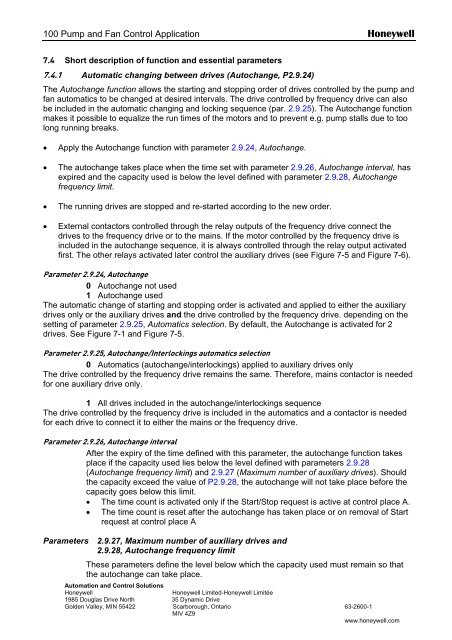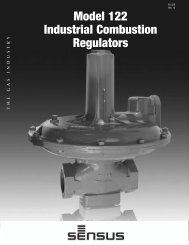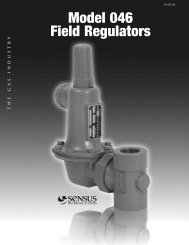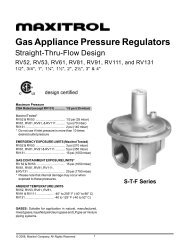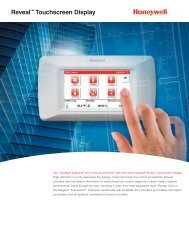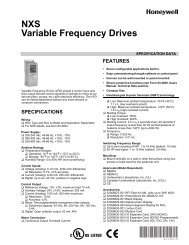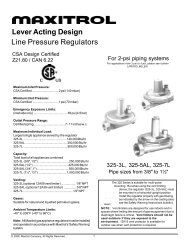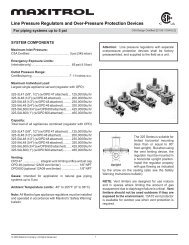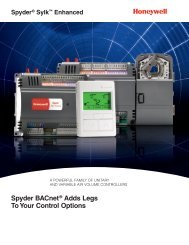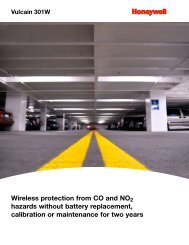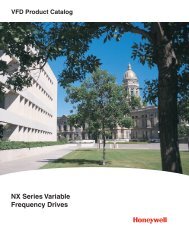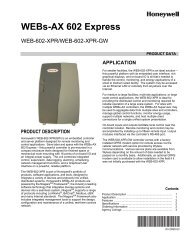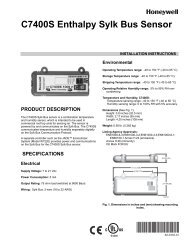NXS Form 63-2600, Users Manual, Technical Data - CONTROL ...
NXS Form 63-2600, Users Manual, Technical Data - CONTROL ...
NXS Form 63-2600, Users Manual, Technical Data - CONTROL ...
- No tags were found...
Create successful ePaper yourself
Turn your PDF publications into a flip-book with our unique Google optimized e-Paper software.
100 Pump and Fan Control Application Honeywell<br />
7.4 Short description of function and essential parameters<br />
7.4.1 Automatic changing between drives (Autochange, P2.9.24)<br />
The Autochange function allows the starting and stopping order of drives controlled by the pump and<br />
fan automatics to be changed at desired intervals. The drive controlled by frequency drive can also<br />
be included in the automatic changing and locking sequence (par. 2.9.25). The Autochange function<br />
makes it possible to equalize the run times of the motors and to prevent e.g. pump stalls due to too<br />
long running breaks.<br />
• Apply the Autochange function with parameter 2.9.24, Autochange.<br />
• The autochange takes place when the time set with parameter 2.9.26, Autochange interval, has<br />
expired and the capacity used is below the level defined with parameter 2.9.28, Autochange<br />
frequency limit.<br />
• The running drives are stopped and re-started according to the new order.<br />
• External contactors controlled through the relay outputs of the frequency drive connect the<br />
drives to the frequency drive or to the mains. If the motor controlled by the frequency drive is<br />
included in the autochange sequence, it is always controlled through the relay output activated<br />
first. The other relays activated later control the auxiliary drives (see Figure 7-5 and Figure 7-6).<br />
Parameter 2.9.24, Autochange<br />
0 Autochange not used<br />
1 Autochange used<br />
The automatic change of starting and stopping order is activated and applied to either the auxiliary<br />
drives only or the auxiliary drives and the drive controlled by the frequency drive. depending on the<br />
setting of parameter 2.9.25, Automatics selection. By default, the Autochange is activated for 2<br />
drives. See Figure 7-1 and Figure 7-5.<br />
Parameter 2.9.25, Autochange/Interlockings automatics selection<br />
0 Automatics (autochange/interlockings) applied to auxiliary drives only<br />
The drive controlled by the frequency drive remains the same. Therefore, mains contactor is needed<br />
for one auxiliary drive only.<br />
1 All drives included in the autochange/interlockings sequence<br />
The drive controlled by the frequency drive is included in the automatics and a contactor is needed<br />
for each drive to connect it to either the mains or the frequency drive.<br />
Parameter 2.9.26, Autochange interval<br />
After the expiry of the time defined with this parameter, the autochange function takes<br />
place if the capacity used lies below the level defined with parameters 2.9.28<br />
(Autochange frequency limit) and 2.9.27 (Maximum number of auxiliary drives). Should<br />
the capacity exceed the value of P2.9.28, the autochange will not take place before the<br />
capacity goes below this limit.<br />
• The time count is activated only if the Start/Stop request is active at control place A.<br />
• The time count is reset after the autochange has taken place or on removal of Start<br />
request at control place A<br />
Parameters 2.9.27, Maximum number of auxiliary drives and<br />
2.9.28, Autochange frequency limit<br />
These parameters define the level below which the capacity used must remain so that<br />
the autochange can take place.<br />
Automation and Control Solutions<br />
Honeywell<br />
Honeywell Limited-Honeywell Limitée<br />
1985 Douglas Drive North 35 Dynamic Drive<br />
Golden Valley, MIN 55422 Scarborough, Ontario <strong>63</strong>-<strong>2600</strong>-1<br />
MIV 4Z9<br />
www.honeywell.com


